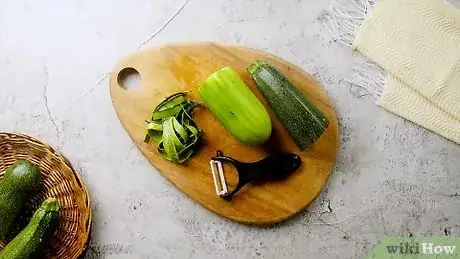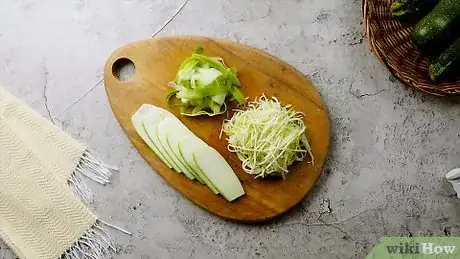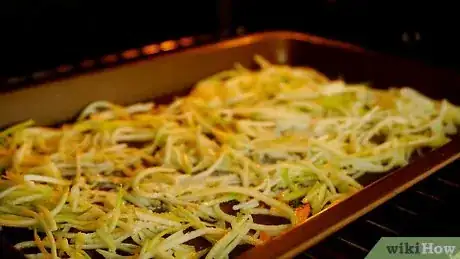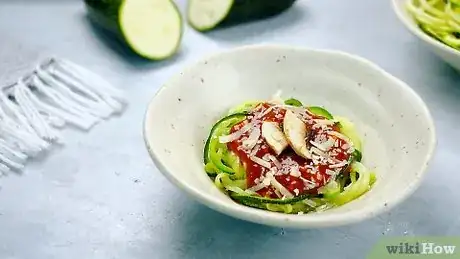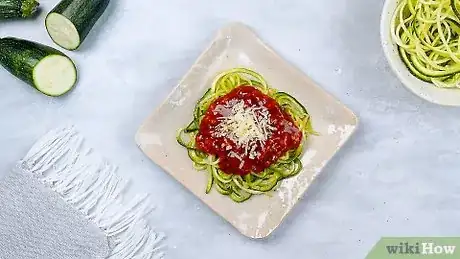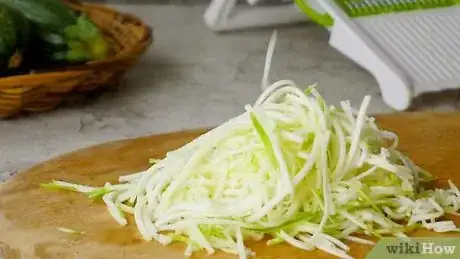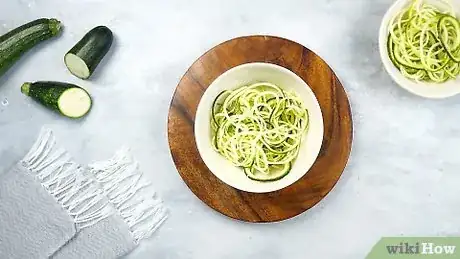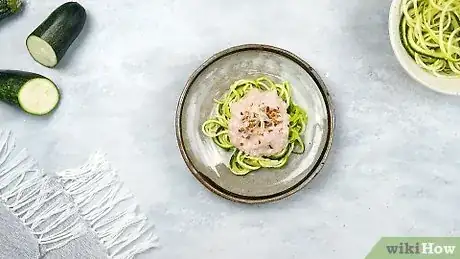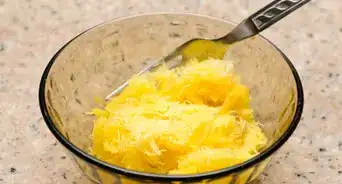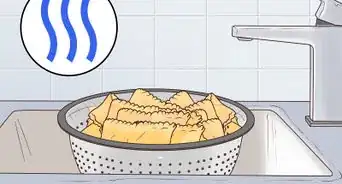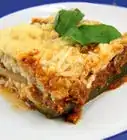This article was co-authored by Ollie George Cigliano. Ollie George Cigliano is a Private Chef, Food Educator, and Owner of Ollie George Cooks, based in Long Beach, California. With over 20 years of experience, she specializes in utilizing fresh, fun ingredients and mixing traditional and innovative cooking techniques. Ollie George holds a BA in Comparative Literature from The University of California, Berkeley, and a Nutrition and Healthy Living Certificate from eCornell University.
wikiHow marks an article as reader-approved once it receives enough positive feedback. This article has 13 testimonials from our readers, earning it our reader-approved status.
This article has been viewed 1,334,874 times.
If you need a healthier, grain-free alternative to standard pasta, you can use zucchini noodles. These noodles are simple to make and taste great. Here's what you need to do to prepare them.
Ingredients
Makes 4 servings
- 4 large zucchini
- Salt (optional)
- 2 Tbsp (30 ml) canola oil (optional)
- Water (optional)
Steps
Cutting the Zucchini Noodles
-
1Decide whether or not to peel the zucchini. If you want zucchini noodles that more closely resemble actual pasta, peel the zucchini before turning it into noodles. For something a little more colorful, though, keep the peel on.
- Keep the zucchini peel on also has health benefits. Primarily, the peel offers extra fiber, and dietary fiber can help regulate your digestive system.
- Slice off one end of the zucchini so that you have a flat surface to place on your counter. Use a vegetable peeler to peel off the dark green skin, revealing the light green flesh beneath it.
-
2Make ribbons. You can make long, thin ribbon noodles using a vegetable peeler or mandolin.
- Pass the peeler or mandolin over the side of the zucchini lengthwise to produce long, flat noodles. When you approach the seeds, turn the zucchini and begin slicing another side. The seeds will prevent the noodles from holding together, so you do not want to use the part with seeds in it.[1]
- If using a mandolin, make sure that you use one of the smallest blade settings in order to produce small, thin noodles.
Advertisement -
3Cut slices. For flexible yet thicker slices suitable for use as lasagna noodles, use a mandolin or sharp kitchen knife.
- Cut slices of the zucchini off the vegetable lengthwise using a knife. The noodles should hold their form but still be fairly thin.
- When you approach the seeds, turn the zucchini and begin slicing another side. The seeds will prevent the noodles from holding together, so you do not want to use the part with seeds in it.
- If using a mandolin, use the thickest blade setting possible. Pass the zucchini over the blade lengthwise to produce long slices.
-
4Prepare spaghetti zucchini noodles. Spaghetti style zucchini noodles can be made using a vegetable peeler, julienne peeler, or mandolin.
- Pass the peeler or julienne peeler down one lengthwise side of the zucchini. Only catch a thin portion of the zucchini, no thicker than 1/2 inch (1.25 cm), for each pass in order to create thin spaghetti-like noodles. If using a julienne peeler, this thickness should already be preset, so no additional work will need to be done on your part.
- If using a mandolin, make sure that the blade is set for a julienne style cut. Pass the zucchini over the blade lengthwise to create thin noodles.
- When you approach the seeds, turn the zucchini and begin slicing another side. The seeds will prevent the noodles from holding together, so you do not want to use the part with seeds in it.
-
5Prepare shredded zucchini noodles. Shredded zucchini noodles can be prepared using a grater.
- Simply pass the grater over the zucchini, pressing firmly to create little rice-like shreds of vegetable. It is still recommended that you work lengthwise instead of widthwise, since you can avoid the seeds more effectively by working lengthwise.
- When you approach the seeds, turn the zucchini and begin shredding another side. The seeds will prevent the noodles from holding together, so you do not want to use the part with seeds in it.
-
6Cut spirals. You can cut spiral noodles a special spiral vegetable cutter.[2]
- Press the zucchini against the blade of the spiral slicer and crank the handle of the simple machine. As you wind the handle and press on the zucchini, thin spirals should come out of the other end of the blade.
-
7Choose whether to cook the zucchini noodles or eat them raw. Zucchini noodles can be enjoyed raw in salads or on their own, but you can also boil, sauté, and microwave them to make them more tender and more reminiscent of actual pasta.
- Zucchini is rather moist and retains a lot of water, however, so you should drain the noodles even if you plan to consume them raw. Instead of “sweating” the noodles, as outlined in this article, you would be better off placing the noodles inside a colander and letting them drip dry for 15 to 20 minutes. When done, wrap the noodles in paper towels and squeeze gently to absorb as much excess moisture as possible.
“Sweating” the Zucchini Noodles
-
1Preheat the oven to 200ºF (95ºC). Prepare a baking sheet by lining it with paper towels.
- Under normal conditions, you would not want to place paper towels in your oven. An oven uses dry heat, which could cause the paper towels to catch fire. Since zucchini contains a large quantity of water, though, the paper towels will quickly become damp enough to prevent them from drying out and catching fire in the oven.
-
2Arrange your zucchini noodles on the baking sheet. Spread the noodles out in as flat a layer as possible.
- If you cannot create a single layer of zucchini noodles, consider using multiple baking sheets instead of just one. In order to properly drain, all of the noodles need to be touching the paper towel lining the pan. Otherwise, the noodles on the bottom may not dry out as evenly as those on the top.
- Sprinkle the zucchini noodles with salt before putting them in the oven. The salt will help draw out some of the moisture.
-
3Let the zucchini noodles "sweat" in the oven. Place the zucchini noodles in the oven and let them bake for 20 to 30 minutes, or until the majority of the moisture inside the noodles has dripped or “sweated” out.
- Sweating is an important part of the process when you plan to prepare a dish with zucchini noodles in it. It is the most effective way to remove moisture from the noodles, and if you do not remove as much moisture as possible before use, the noodles could actually cause your final dish to become watery.
-
4Squeeze out any additional moisture. Wrap the paper towels around the zucchini noodles and squeeze the noodles gently to get any remaining moisture out.
- Note that the noodles will be dry at this point but no longer soft. As a result, you will need to cook them further.
Boiling the Zucchini Noodles
-
1Bring a saucepan of water to a boil. Fill a medium saucepan between 1/2 and 2/3 full with water. Place it on the stove and heat it over medium-high until the water reaches a rolling boil.
- Add salt. After the water reaches a boil, add a generous amount of salt to the water. The zucchini will absorb the salt as it cooks, thereby becoming flavored on both the inside and outside. You can add salt before the water reaches a boil, but doing so will cause the water to take a longer amount of time to reach a steady boil.
-
2Add the zucchini noodles and cook briefly. Place the zucchini noodles in the boiling water and cook until they are tender but not quite falling apart.
- The exact amount of cooking time will vary depending on how soft you want the zucchini noodles and how dry they are when you start. If the noodles are still fairly moist, 2 minutes should be long enough. If they are very dry, however, you will need to cook them 10 minutes for al dente noodles and 15 for soft, silky noodles.[3]
- The main thing to remember is simply to keep an eye on them. If the noodles start breaking apart, you need to stop the cooking process.
-
3Serve. Drain the water and transfer the zucchini noodles to individual serving plates.
- Drain the water by pouring the zucchini noodles through a colander. Let stand for 5 minutes or so, just long enough for any excess water to finish dripping off each noodle.
Sauteing the Zucchini Noodles
-
1Heat cooking oil in a skillet. Add about 2 Tbsp (30 ml) of canola oil or your preferred cooking oil to a large skillet and heat on medium-high until smoother and glossier.
- Carefully turn and rotate the pan to coat the entire bottom with the hot oil. When the oil is hot enough, you should be able to spread it in this manner with ease.
-
2sauté the zucchini noodles briefly. Add the zucchini noodles to the hot oil and sauté them for 6 to 7 minutes, stirring frequently.
- Keep a close eye on the zucchini noodles as they cook. If you allow them to stick to one spot for too long, they may begin to burn, stick to the pan, and fall apart.
- This cooking method produces noodles that are tender yet slightly crispier than those created through the boiling method.
-
3Serve. Transfer the zucchini noodles to individual serving plates and enjoy.
- You can save any leftover zucchini noodles after cooking them. They maintain their taste and texture for a day or so in the refrigerator, so they can be enjoyed cold or reheated for another meal.
Microwaving the Zucchini Noodles
-
1Start with partially damp noodles. For this method, you should let the zucchini noodles retain some of their natural moisture so that they will cook without drying out completely in the microwave.
- You can skip the sweating portion of the instructions altogether or simply skip the part in which you wring out extra moisture using the paper towels. That said, you may still want to let the zucchini noodles drain in a colander for 10 minutes or so before microwaving them.
- If you do happen to dry the zucchini noodles out beforehand, you can still use this cooking method. Simply add 2 to 3 Tbsp (30 to 45 ml) of water to the dish with the zucchini noodles to provide the noodles with just enough moisture to keep from drying out.
-
2Place the zucchini noodles in a microwave-safe dish. Arrange them in an even layer and cover loosely with a microwave-safe lid or piece of microwave-safe plastic wrap.
- The seal should not be especially tight. If you use a lid, open any vents in the lid or leave it partially cracked open to vent the dish as it cooks. If you use plastic wrap, drape the plastic wrap over the top instead of securing it on tightly.
-
3Microwave on high for 2 minutes.[4] Cook the zucchini noodles until tender but not yet falling apart.
- Keep a close eye on the zucchini noodles as they cook. If you overcook them, they could become soggy, hard, or otherwise gross.
-
4Serve. Drain the excess liquid and transfer the zucchini noodles to individual serving plates.
- There will almost always be excess liquid in the dish after you make zucchini noodles in the microwave. You can drain the liquid easily using a colander.
Community Q&A
-
QuestionCan zucchini be frozen? I have so much! What do I do with it all?
 Community AnswerMake soup with it. Sweat down some onion, add curry spices, vegetables and stock. Bring to a boil, then leave to simmer until the veggies are soft. Use a stick blender to whizz the soup until it is of a creamy consistency. This soup can then be frozen. Zucchini noodles could also be frozen, but they may be a little more watery when thawed.
Community AnswerMake soup with it. Sweat down some onion, add curry spices, vegetables and stock. Bring to a boil, then leave to simmer until the veggies are soft. Use a stick blender to whizz the soup until it is of a creamy consistency. This soup can then be frozen. Zucchini noodles could also be frozen, but they may be a little more watery when thawed. -
QuestionWill the size of a zucchini affect the taste?
 QamarTop AnswererNo, not really. The size of the zucchini mainly affects the amount of noodles the recipe makes.
QamarTop AnswererNo, not really. The size of the zucchini mainly affects the amount of noodles the recipe makes. -
QuestionWhat item do I purchase so I can make the noodles?
 Fae LynneCommunity AnswerSeveral items have been developed for this. Look for the "Spiralizer", the "Veggetti", or the "Original Zoodle Maker" as the best known brands.
Fae LynneCommunity AnswerSeveral items have been developed for this. Look for the "Spiralizer", the "Veggetti", or the "Original Zoodle Maker" as the best known brands.
Things You'll Need
- Vegetable peeler
- Mandolin
- Grater
- Spiral slicer
- Sharp knife with a smooth blade
- Colander
- Baking sheet
- Paper towels
- Saucepan
- Skillet
- Microwave-safe dish
- Plastic wrap
References
About This Article
To make zucchini noodles, use a kitchen knife to cut the zuchinni vertically into thin, long pieces that resemble lasagna noodles. For thinner noodles that look like ribbons, use a vegetable peeler to shave off long, vertical strips of the zucchini, leaving behind the center pieces that have the most seeds and won’t hold together. If you want noodles that resemble spaghetti, pass the vegetable lengthwise down a mandolin that’s been set to a julienne cut, or use a julienne peeler to do the same. For tips on how to prepare both raw and cooked dishes with your zucchini noodles, read on!
